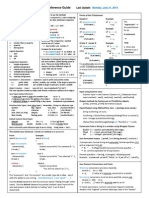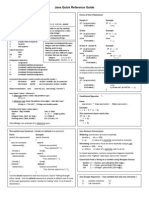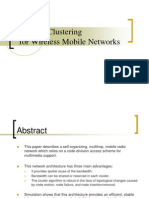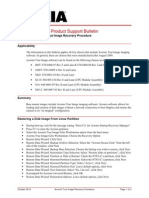Fsharp Cheatsheet
Uploaded by
rajeevsahaniFsharp Cheatsheet
Uploaded by
rajeevsahaniF# Cheatsheet
This cheatsheet glances over some of the common syntax of
F# 3.0. If you have any comments, corrections, or suggested
additions, please open an issue or send a pull request to
https://github.com/dungpa/fsharp-cheatsheet.
Comments
Block comments are placed between (* and *). Line
comments start from // and continue until the end of the line.
Functions
The let keyword also defines named functions.
let negate x = x * -1
let square x = x * x
let print x = printfn "The number is: %d" x
XML doc comments come after /// allowing us to use XML
tags to generate documentation.
/// The let keyword defines an (immutable) value
let result = 1 + 1 = 2
Strings
F# string type is an alias for System.String type.
/// Create a string using string concatenation
let hello = "Hello" + " World"
let fst (x, _) = x
Pipe and composition operators
/// Similar to fib; using function for pattern matching
let rec fib = function
| 0 -> 0
| 1 -> 1
| n -> fib (n - 1) + fib (n - 2)
Pipe operator |> is used to chain functions and arguments
together. Double-backtick identifiers are handy to improve
readability especially in unit testing:
For more complete reference visit Pattern Matching (MSDN).
This operator is essential in assisting the F# type checker by
providing type information before use:
Lists
let verbatimXml = @"<book title=""Paradise Lost"">"
let squareNegateThenPrint =
square >> negate >> print
let tripleXml = """<book title="Paradise Lost">"""
Recursive functions
Backslash strings indent string contents by stripping leading
spaces.
The rec keyword is used together with the let keyword to
define a recursive function:
let poem =
"The lesser world was daubed\n\
By a colorist of modest skill\n\
A master limned you in the finest inks\n\
And with a fresh-cut quill."
let rec fact x =
if x < 1 then 1
else x * fact (x - 1)
Most numeric types have associated suffixes, e.g., uy for
unsigned 8-bit integers and L for signed 64-bit integer.
Other common examples are F or f for 32-bit floating-point
numbers, M or m for decimals, and I for big integers.
let s, f, d, bi = 4.14F, 4.14, 0.7833M, 9999I
//
//
//
//
val
val
val
val
s : float32 = 4.14f
f : float = 4.14
d : decimal = 0.7833M
bi : System.Numerics.BigInteger = 9999
See Literals (MSDN) for complete reference.
// Lists use square brackets and ; delimiter
let list1 = [ "a"; "b" ]
// :: is prepending
let list2 = "c" :: list1
// @ is concat
let list3 = list1 @ list2
// Recursion on list using (::) operator
let rec sum list =
match list with
| [] -> 0
| x :: xs -> x + sum xs
Arrays
Arrays are fixed-size, zero-based, mutable collections of
consecutive data elements.
Mutually recursive functions (those functions which call each
other) are indicated by and keyword:
let rec even x =
if x = 0 then true
else odd (x - 1)
// Arrays use square brackets with bar
let array1 = [| "a"; "b" |]
// Indexed access using dot
let first = array1.[0]
Sequences
let b, i, l = 86uy, 86, 86L
// val b : byte = 86uy
// val i : int = 86
// val l : int64 = 86L
Collections
A list is an immutable collection of elements of the same type.
let sumOfLengths (xs : string []) =
xs
|> Array.map (fun s -> s.Length)
|> Array.sum
Composition operator is used to compose functions:
Basic Types and Literals
or implicitly via function keyword:
let square, negate, then print x =
x |> square |> negate |> print
Use verbatim strings preceded by @ symbol to avoid escaping
control characters (except escaping " by "").
We dont even have to escape " with triple-quoted strings.
Pattern matching can be done directly on arguments:
let squareNegateThenPrint x =
print (negate (square x))
(* This is block comment *)
// And this is line comment
let sign x =
match x with
| 0 -> 0
| x when x < 0 -> -1
| x -> 1
A sequence is a logical series of elements of the same type.
Individual sequence elements are computed only as required,
so a sequence can provide better performance than a list in
situations in which not all the elements are used.
and odd x =
if x = 1 then true
else even (x - 1)
Pattern Matching
Pattern matching is often facilitated through match keyword.
let rec fib n =
match n with
| 0 -> 0
| 1 -> 1
| _ -> fib (n - 1) + fib (n - 2)
In order to match sophisticated inputs, one can use when to
create filters or guards on patterns:
// Sequences can use yield and contain subsequences
let seq1 =
seq {
// "yield" adds one element
yield 1
yield 2
// "yield!" adds a whole subsequence
yield! [5..10]
}
Higher-order functions on collections
The same list [ 1; 3; 5; 7; 9 ] or array [| 1; 3; 5; 7; 9
|] can be generated in various ways.
Using range operator ..
let xs = [ 1..2..9 ]
Using list or array comprehensions
let ys = [| for i in 0..4 -> 2 * i + 1 |]
Exceptions
let c = fst (1, 2)
let d = snd (1, 2)
The failwith function throws an exception of type Exception.
let print tuple =
match tuple with
| (a, b) -> printfn "Pair %A %A" a b
let divideFailwith x y =
if y = 0 then
failwith "Divisor cannot be zero."
else x / y
Records represent simple aggregates of named values,
optionally with members:
Exception handling is done via try/with expressions.
// Declare a record type
type Person = { Name : string; Age : int }
Using init function
let zs = List.init 5 (fun i -> 2 * i + 1)
Lists and arrays have comprehensive sets of higher-order
functions for manipulation.
fold starts from the left of the list (or array) and
foldBack goes in the opposite direction
let xs = Array.fold (fun str n ->
sprintf "%s,%i" str n) "" [| 0..9 |]
reduce doesnt require an initial accumulator
let last xs = List.reduce (fun acc x -> x) xs
map transforms every element of the list (or array)
let ys = Array.map (fun x -> x * x) [| 0..9 |]
iterate through a list and produce side effects
List.iter (fun x -> printfn "%i" x) [ 0..9 ]
All these operations are also available for sequences. The
added benefits of sequences are laziness and uniform treatment
of all collections implementing IEnumerable<T>.
let zs =
seq {
for i in 0..9 do
printfn "Adding %d" i
yield i
}
Tuples and Records
A tuple is a grouping of unnamed but ordered values, possibly
of different types:
// Tuple construction
let x = (1, "Hello")
// Triple
let y = ("one", "two", "three")
// Tuple deconstruction / pattern
let (a, b) = x
The first and second elements of a tuple can be obtained using
fst, snd, or pattern matching:
// Create a value via record expression
let paul = { Name = "Paul"; Age = 28 }
// Copy and update record expression
let paulsTwin = { paul with Name = "Jim" }
Records can be augmented with properties and methods:
type Person with
member x.Info = (x.Name, x.Age)
Records are essentially sealed classes with extra topping:
default immutability, structural equality, and pattern
matching support.
let isPaul person =
match person with
| { Name = "Paul" } -> true
| _ -> false
Discriminated Unions
let divide x y =
try
Some (x / y)
with :? System.DivideByZeroException ->
printfn "Division by zero!"
None
The try/finally expression enables you to execute clean-up
code even if a block of code throws an exception. Heres an
example which also defines custom exceptions.
exception InnerError of string
exception OuterError of string
let handleErrors x y =
try
try
if x = y then raise (InnerError("inner"))
else raise (OuterError("outer"))
with InnerError(str) ->
printfn "Error1 %s" str
finally
printfn "Always print this."
Discriminated unions (DU) provide support for values that
can be one of a number of named cases, each possibly with
different values and types.
Classes and Inheritance
type Tree<T> =
| Node of Tree<T> * T * Tree<T>
| Leaf
type Vector(x : float, y : float) =
let mag = sqrt(x * x + y * y) // (1)
member this.X = x // (2)
member this.Y = y
member this.Mag = mag
member this.Scale(s) = // (3)
Vector(x * s, y * s)
static member (+) (a : Vector, b : Vector) = // (4)
Vector(a.X + b.X, a.Y + b.Y)
let rec depth = function
| Node(l, _, r) -> 1 + depth l + depth r
| Leaf -> 0
F# Core has a few built-in discriminated unions for error
handling, e.g., Option and Choice.
This example is a basic class with (1) local let bindings, (2)
properties, (3) methods, and (4) static members.
let optionPatternMatch input =
match input with
| Some i -> printfn "input is an int=%d" i
| None -> printfn "input is missing"
Call a base class from a derived one.
Single-case discriminated unions are often used to create
type-safe abstractions with pattern matching support:
type Dog() =
inherit Animal()
member __.Run() =
base.Rest()
type OrderId = Order of string
type Animal() =
member __.Rest() = ()
Upcasting is denoted by :> operator.
// Create a DU value
let orderId = Order "12"
let dog = Dog()
let animal = dog :> Animal
// Pattern matching of single-case DU
let (Order id) = orderId
Dynamic casting (:?>) might throw an exception if the cast
doesnt succeed at runtime.
let probablyADog = animal :?> Dog
Interfaces and Object Expressions
Declare IVector interface and implement it in Vector.
type IVector =
abstract Scale : float -> IVector
type Vector(x, y) =
interface IVector with
member __.Scale(s) =
Vector(x * s, y * s) :> IVector
member __.X = x
member __.Y = y
Another way of implementing interfaces is to use object
expressions.
type ICustomer =
abstract Name : string
abstract Age : int
let createCustomer name age =
{ new ICustomer with
member __.Name = name
member __.Age = age }
Partial active patterns share the syntax of parameterized
patterns but their active recognizers accept only one argument.
Active Patterns
Compiler Directives
Complete active patterns:
Load another F# source file into FSI.
let (|Even|Odd|) i =
if i % 2 = 0 then Even else Odd
#load "../lib/StringParsing.fs"
let testNumber i =
match i with
| Even -> printfn "%d is even" i
| Odd -> printfn "%d is odd" i
Parameterized active patterns:
Reference a .NET assembly (/ symbol is recommended for
Mono compatibility).
#r "../lib/FSharp.Markdown.dll"
Include a directory in assembly search paths.
#I "../lib"
#r "FSharp.Markdown.dll"
let (|DivisibleBy|_|) by n =
if n % by = 0 then Some DivisibleBy else None
Other important directives are conditional execution in FSI
(INTERACTIVE) and querying current directory
(__SOURCE_DIRECTORY__).
let fizzBuzz = function
| DivisibleBy 3 & DivisibleBy 5 -> "FizzBuzz"
| DivisibleBy 3 -> "Fizz"
| DivisibleBy 5 -> "Buzz"
| _ -> ""
#if INTERACTIVE
let path = __SOURCE_DIRECTORY__ + "../lib"
#else
let path = "../../../lib"
#endif
You might also like
- 5.lists: 5.1. Accessing Values in Lists ExNo ratings yet5.lists: 5.1. Accessing Values in Lists Ex8 pages
- Lahore Garrison University: Course Syllabus DescriptionNo ratings yetLahore Garrison University: Course Syllabus Description4 pages
- Java Quick Reference Guide: String ComparisonsNo ratings yetJava Quick Reference Guide: String Comparisons2 pages
- Introduction To Computer Programming ProgrammingNo ratings yetIntroduction To Computer Programming Programming54 pages
- Getting Started With Ataccama DQ Analyzer 6 Pg. 1No ratings yetGetting Started With Ataccama DQ Analyzer 6 Pg. 126 pages
- Big Java Book All Solution +++ by Sujan Prodhan Rajshahi UniversityNo ratings yetBig Java Book All Solution +++ by Sujan Prodhan Rajshahi University124 pages
- Chapter-1: Operating System and Its TypesNo ratings yetChapter-1: Operating System and Its Types34 pages
- C Program To Convert Binary Number To Octal and Octal To BinaryNo ratings yetC Program To Convert Binary Number To Octal and Octal To Binary3 pages
- VIP Cheatsheet: Convolutional Neural Networks: Afshine Amidi and Shervine Amidi November 26, 2018No ratings yetVIP Cheatsheet: Convolutional Neural Networks: Afshine Amidi and Shervine Amidi November 26, 20185 pages
- Doubly Linked List Polynomial Addition MultiplicationNo ratings yetDoubly Linked List Polynomial Addition Multiplication5 pages
- Stochastic Technologies Available As A Short EbookNo ratings yetStochastic Technologies Available As A Short Ebook8 pages
- Neo4j Certified Professional - My Achievements - Free Neo4j Courses From GraphAcademyNo ratings yetNeo4j Certified Professional - My Achievements - Free Neo4j Courses From GraphAcademy1 page
- A Gentle Introduction To Mini-Batch Gradient Descent and How To Configure Batch SizeNo ratings yetA Gentle Introduction To Mini-Batch Gradient Descent and How To Configure Batch Size16 pages
- Hindustan College of Science & Technology Department of Information Technology Minor Test-01 Schedule EVEN SEMESTER (2015-16)No ratings yetHindustan College of Science & Technology Department of Information Technology Minor Test-01 Schedule EVEN SEMESTER (2015-16)2 pages
- Rearrangement of Jumbled Sentences To Make A Meaningful ParagraphNo ratings yetRearrangement of Jumbled Sentences To Make A Meaningful Paragraph21 pages
- Adaptive Clustering For Wireless Mobile NetworksNo ratings yetAdaptive Clustering For Wireless Mobile Networks30 pages
- Qno. 5 SQL 2014 Q.Paper: (B) Write The SQL Queries (1 To 4)No ratings yetQno. 5 SQL 2014 Q.Paper: (B) Write The SQL Queries (1 To 4)37 pages
- Data Access and User Authentication PolicyNo ratings yetData Access and User Authentication Policy3 pages
- PCI DSS v3 - 2 - 1 ROC S6 R3 Protect Stored Cardholder DataNo ratings yetPCI DSS v3 - 2 - 1 ROC S6 R3 Protect Stored Cardholder Data18 pages
- Third Year Engineering: 21BTCS604 - Advanced DBMSNo ratings yetThird Year Engineering: 21BTCS604 - Advanced DBMS24 pages
- 300+ REAL TIME DATABASE MANAGEMENT SYSTEM Questions & Answers 2023No ratings yet300+ REAL TIME DATABASE MANAGEMENT SYSTEM Questions & Answers 202332 pages
- PDF 7 Aneis Egberto Gismonti - CompressNo ratings yetPDF 7 Aneis Egberto Gismonti - Compress11 pages
- HP 3par Storeserv 10000 Storage: Raising The BarNo ratings yetHP 3par Storeserv 10000 Storage: Raising The Bar8 pages
- TC1765 OmniPCX Office SIP Trunking Noteworthy Addresses en Ed02No ratings yetTC1765 OmniPCX Office SIP Trunking Noteworthy Addresses en Ed0214 pages
- @vtucode - In-Dd&c0 Question Bank With Solution100% (2)@vtucode - In-Dd&c0 Question Bank With Solution31 pages
- Tableau Resources For Combining Multiple Data SourcesNo ratings yetTableau Resources For Combining Multiple Data Sources1 page






































































































